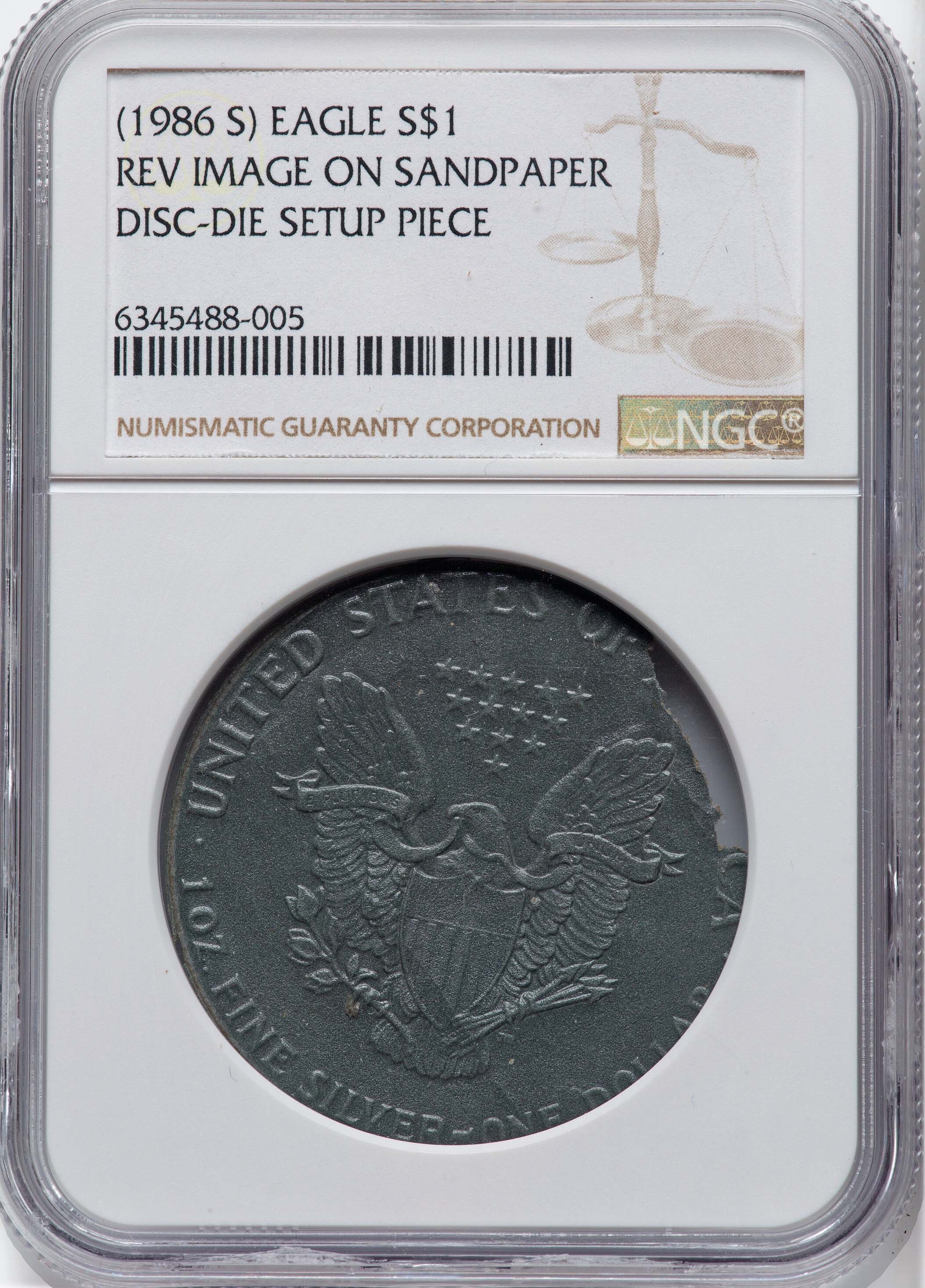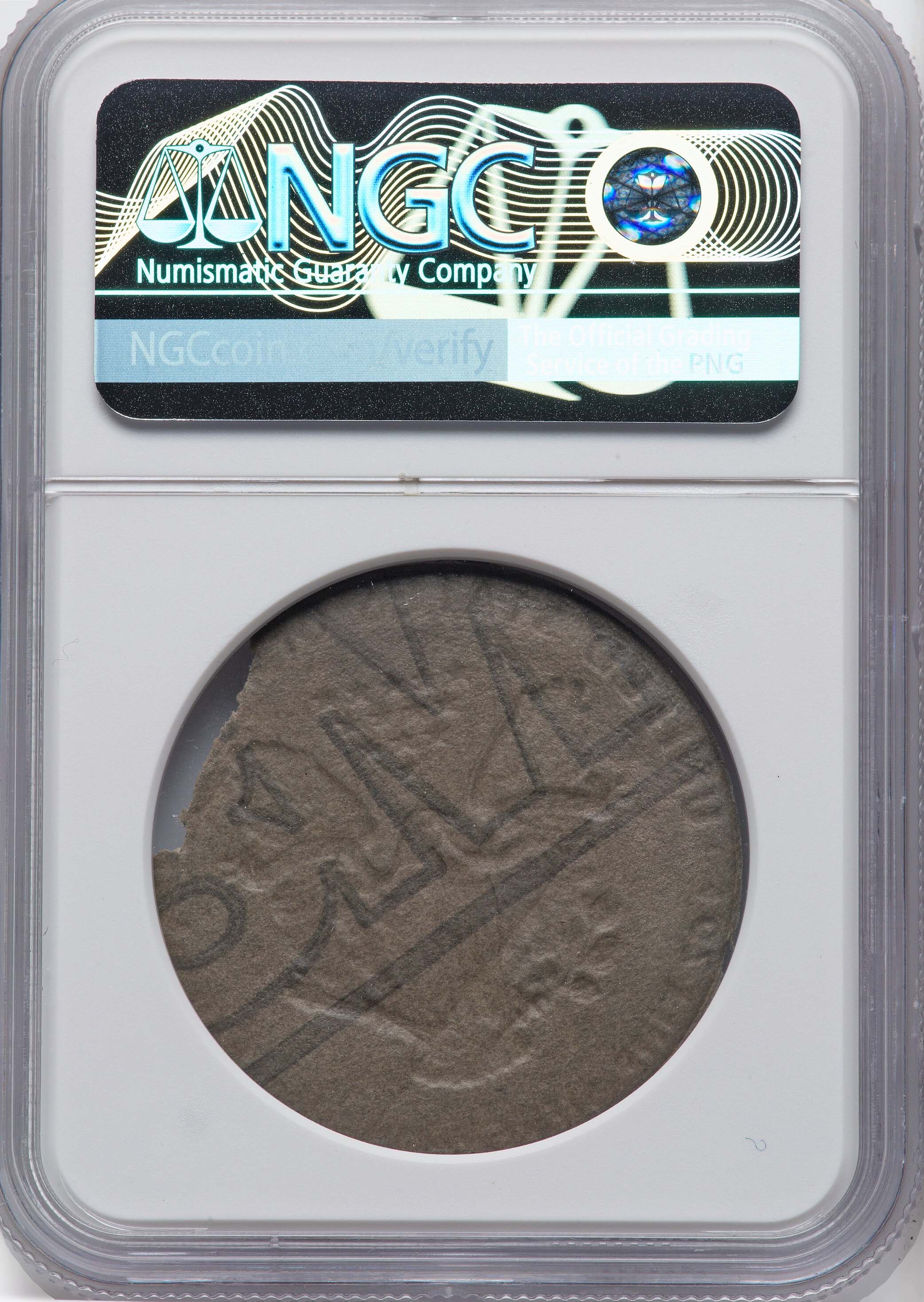The following mint errors are featured in the upcoming May 2024 CSNS US Coins Signature® Auction #1374.
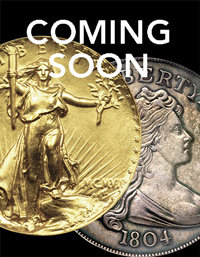
Images Courtesy of Heritage Auctions, HA.com
1973-S Ike Dollar Mated Pair, PR65
Clad Dollar Struck Through Silver-Clad Layer
1973-S $1 Clad Eisenhower Dollar -- Struck Through Silver Layer, Mated Pair -- PR65 NGC. Similar to modern clad coinage, a clad Ike dollar has two outer layers of 75% copper, 25% nickel and an inner core of pure copper. Proof 1973-S Ike dollars were struck in both silver clad and copper-nickel clad alloys. The silver clad proofs had outer layers of 80% silver and an inner core of 20.9% silver. To create the present mated pair, an outer silver-clad layer separated from a silver-clad planchet, and was fed together with a copper-nickel clad Ike planchet. The silver-clad layer was struck between the obverse die and the copper-nickel planchet. The struck silver-clad layer has a normal appearance when viewed from the obverse. The reverse exhibits an incused, reversed, and somewhat indistinct image of the obverse. The reverse of the copper-nickel clad dollar has a normal appearance, but the obverse appears blurry, since the strike from the obverse die was blunted by the silver-clad layer.
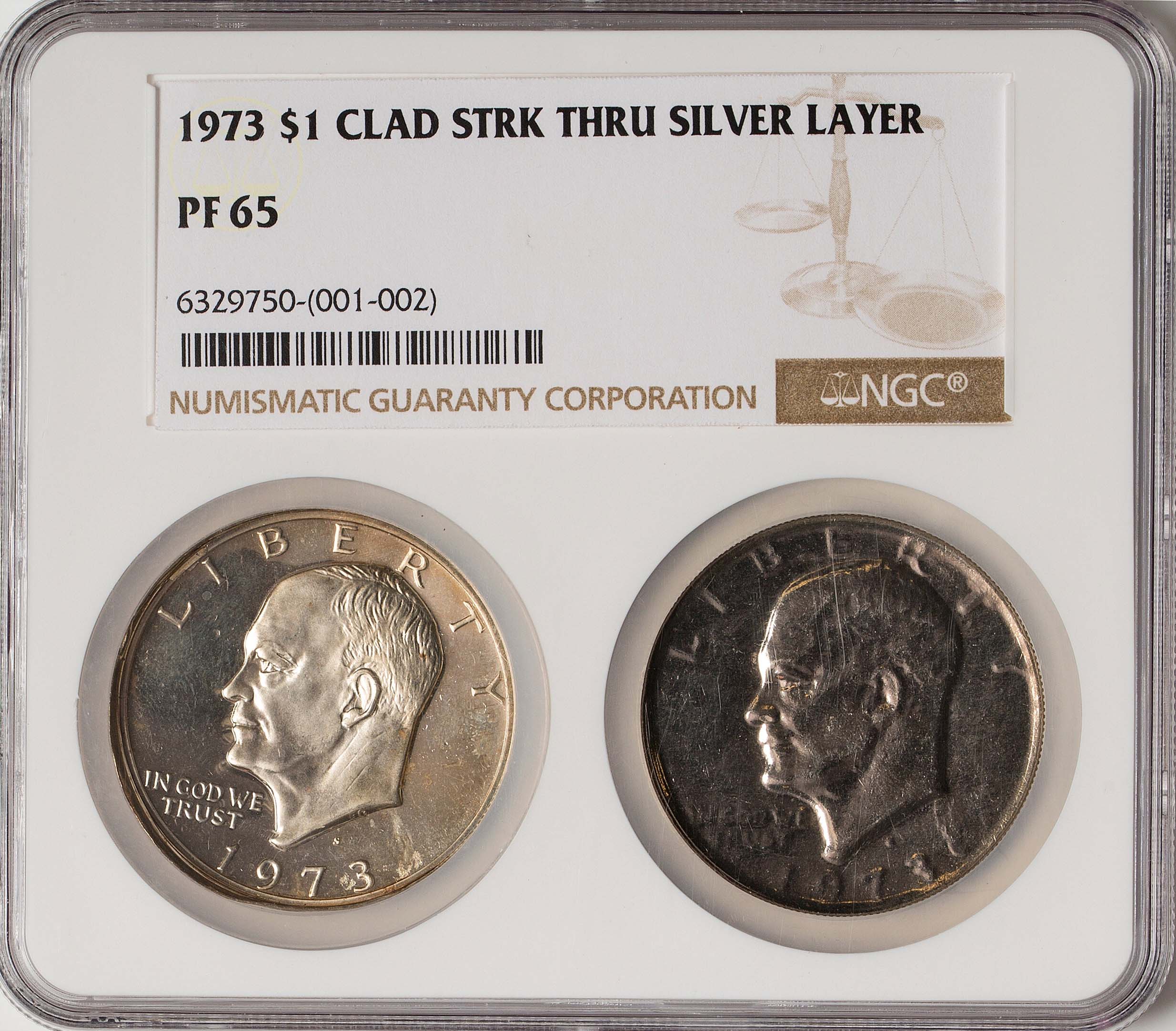
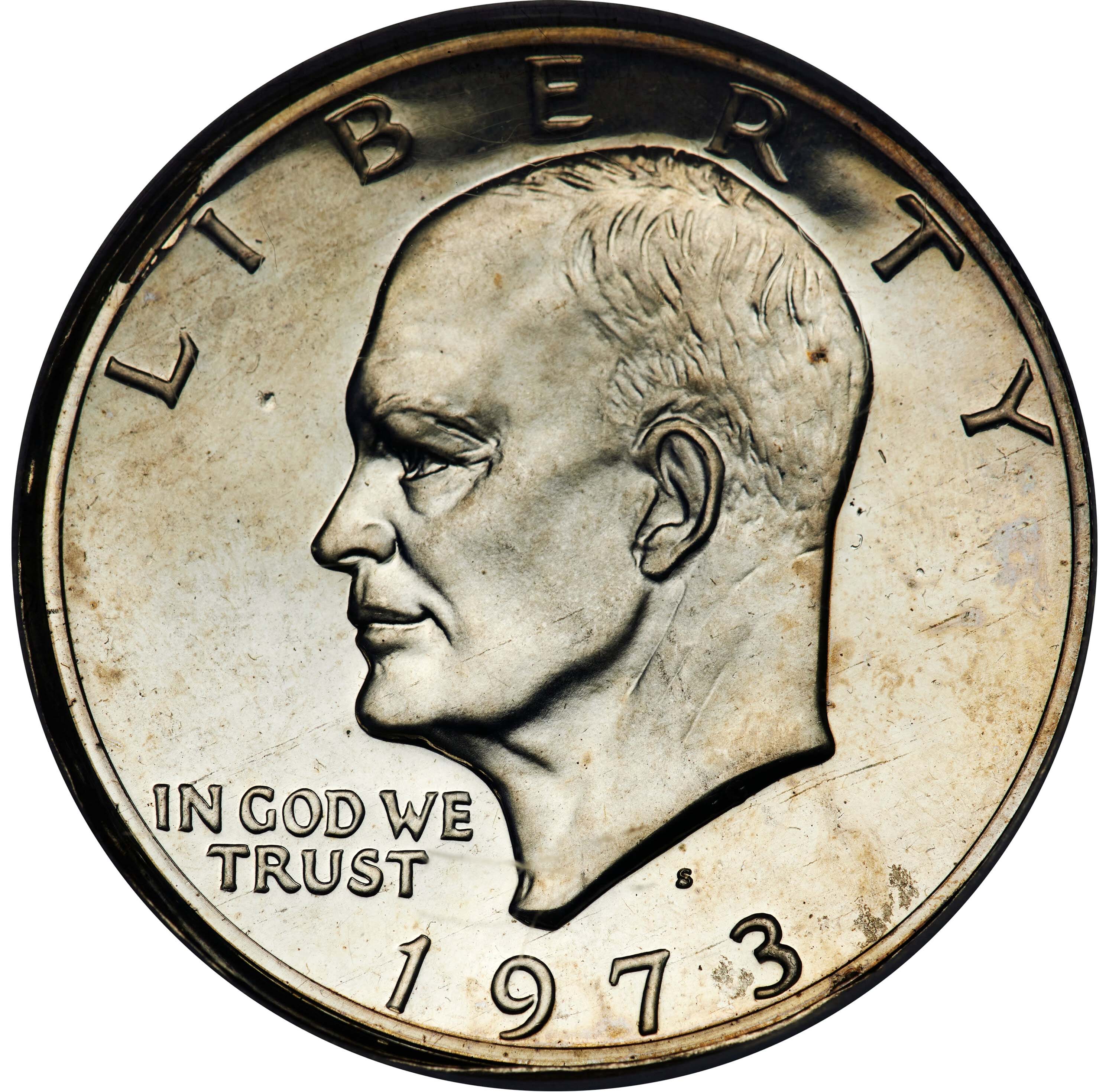
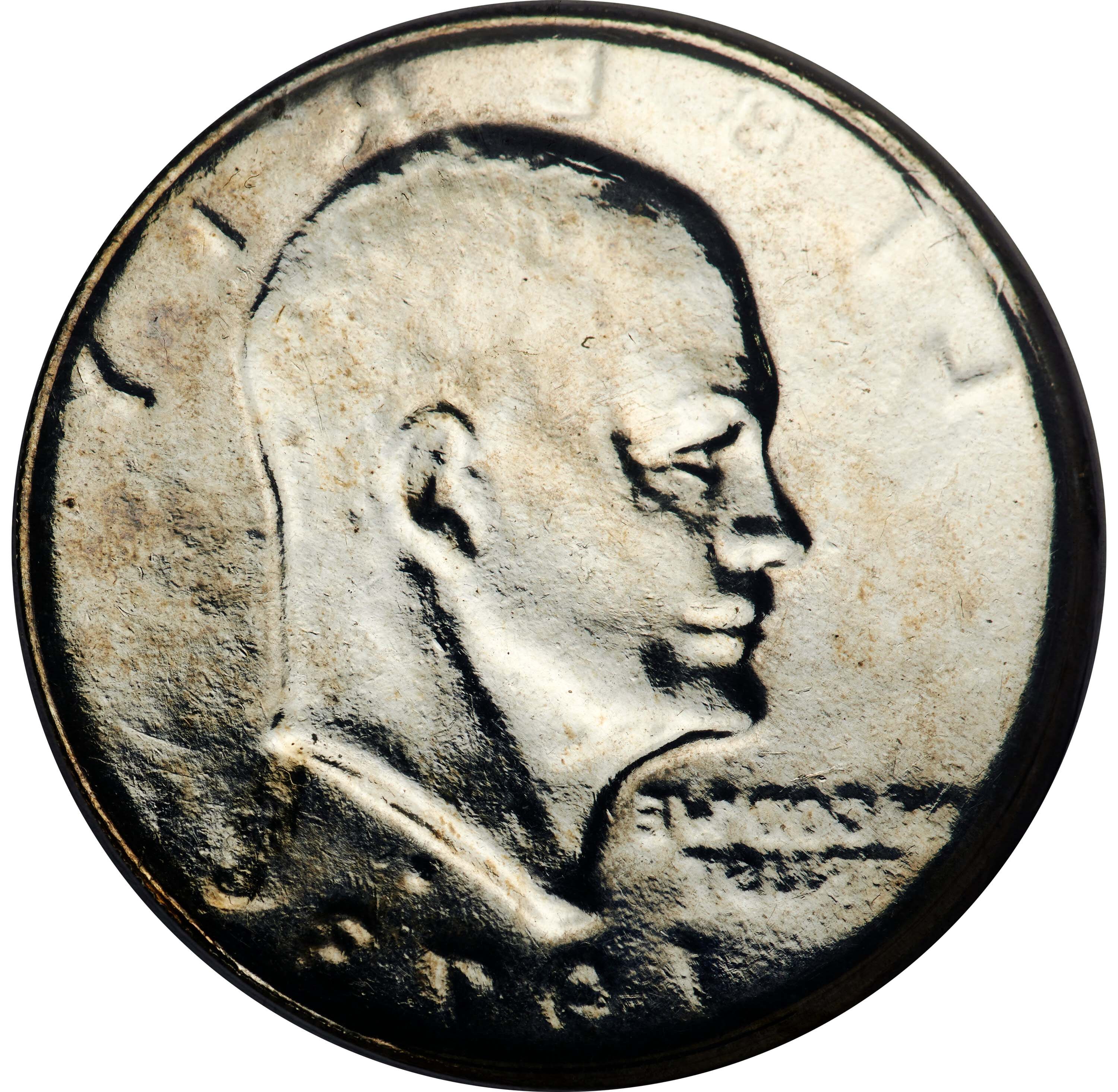
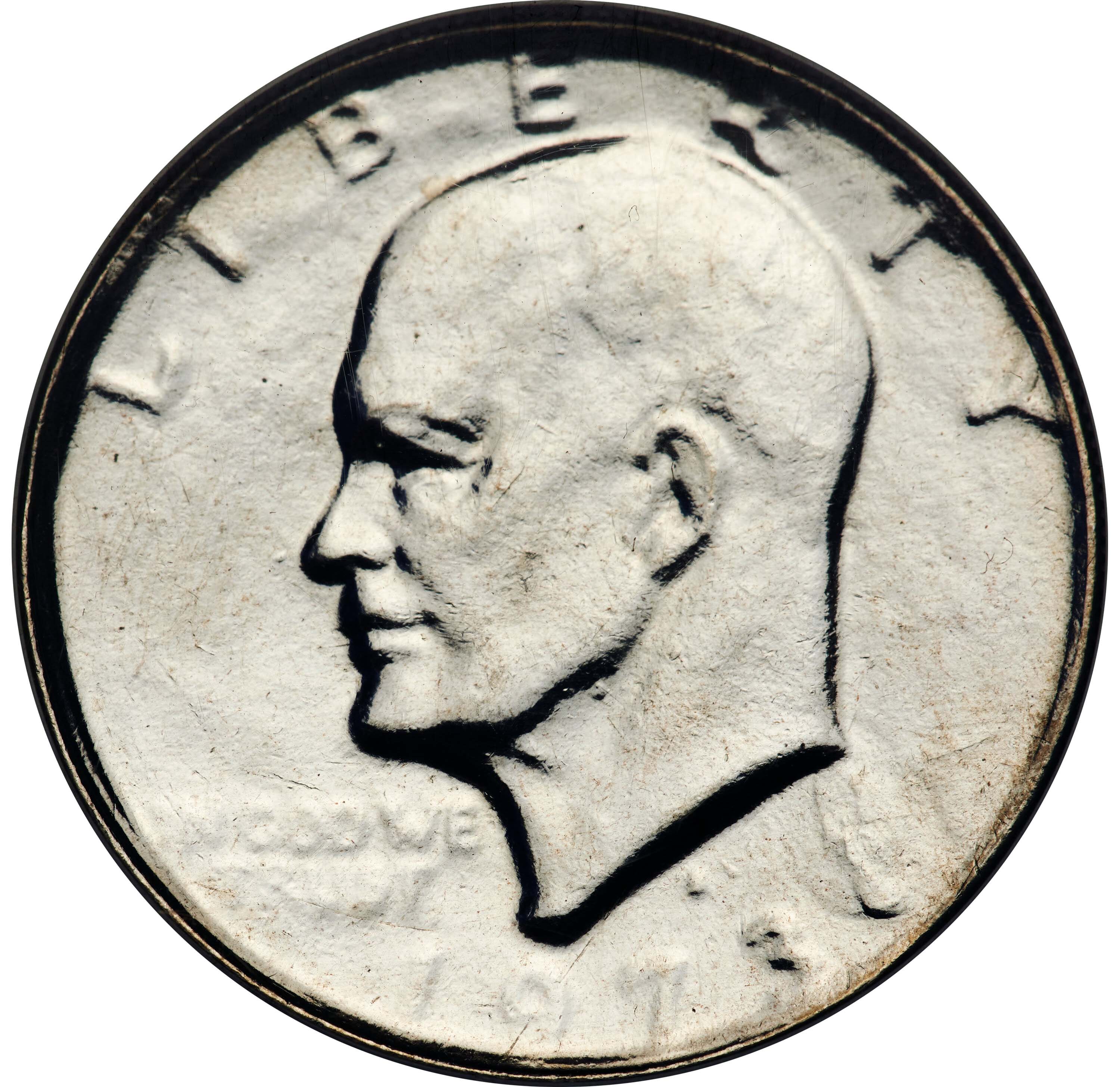
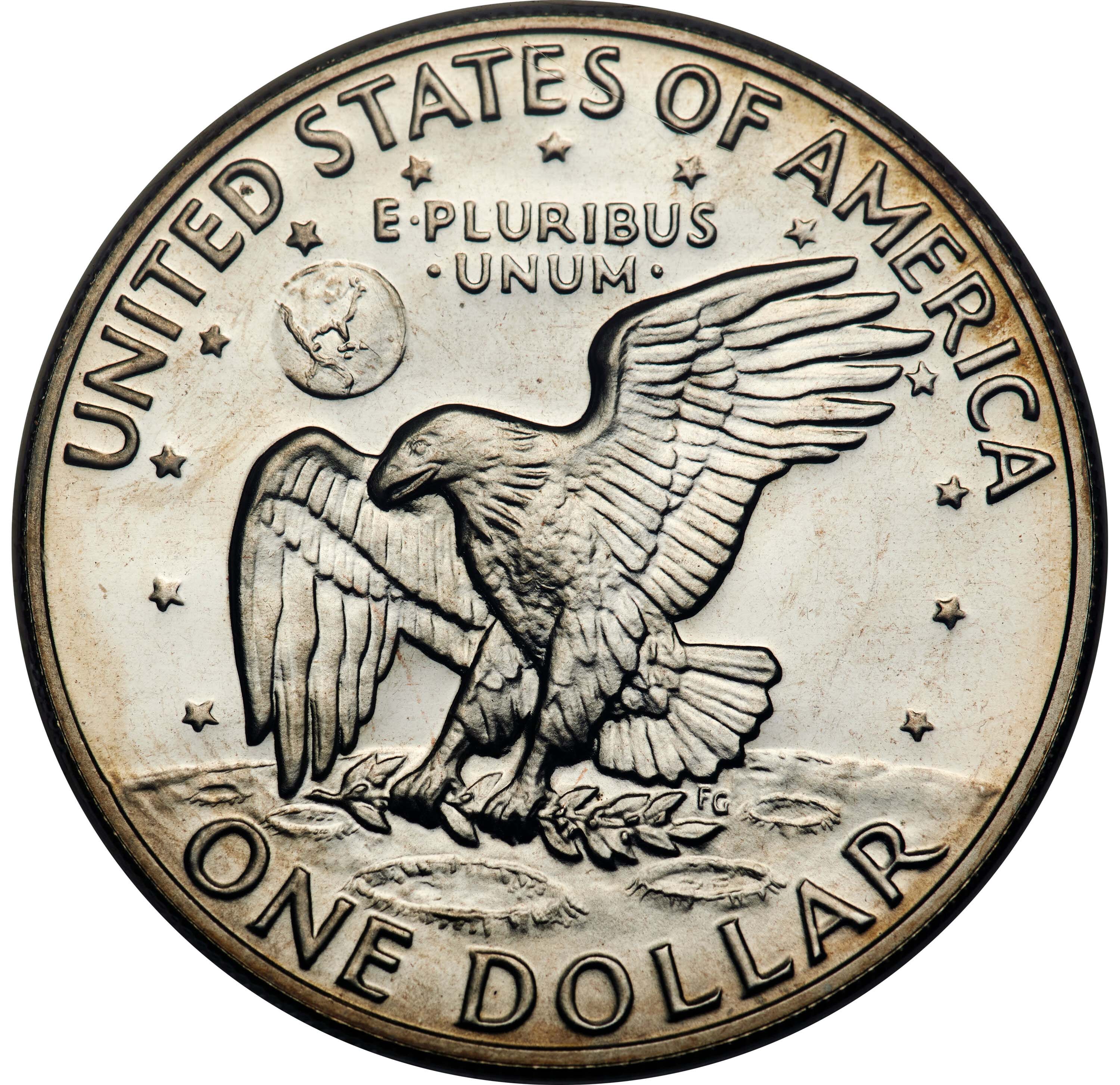
1971-S Ike Dollar, PR68 Ultra Cameo
Double Struck, Both Sides Off Center
1971-S $1 Silver Eisenhower Dollar -- Double Struck, Both Sides Off Center -- PR68 Ultra Cameo NGC. Type Two Reverse. A spectacular proof Ike dollar mint error. The first strike was approximately 15% off center toward 10:30. The second strike was about 20% off center toward 12 o'clock, at 1:30 relative to the first strike. All of the Ike portrait is present from the second strike. Ike's full profile remains from the second strike. Both strikes include three digits of the date. The mintmark from the second strike is bold. The mintmark from the first strike is faint but evident. Both Earths are complete. The eagle from the second strike is full. The back wing of the eagle remains from the first strike. Traces of the reddish copper core are struck into the lower reverse border.

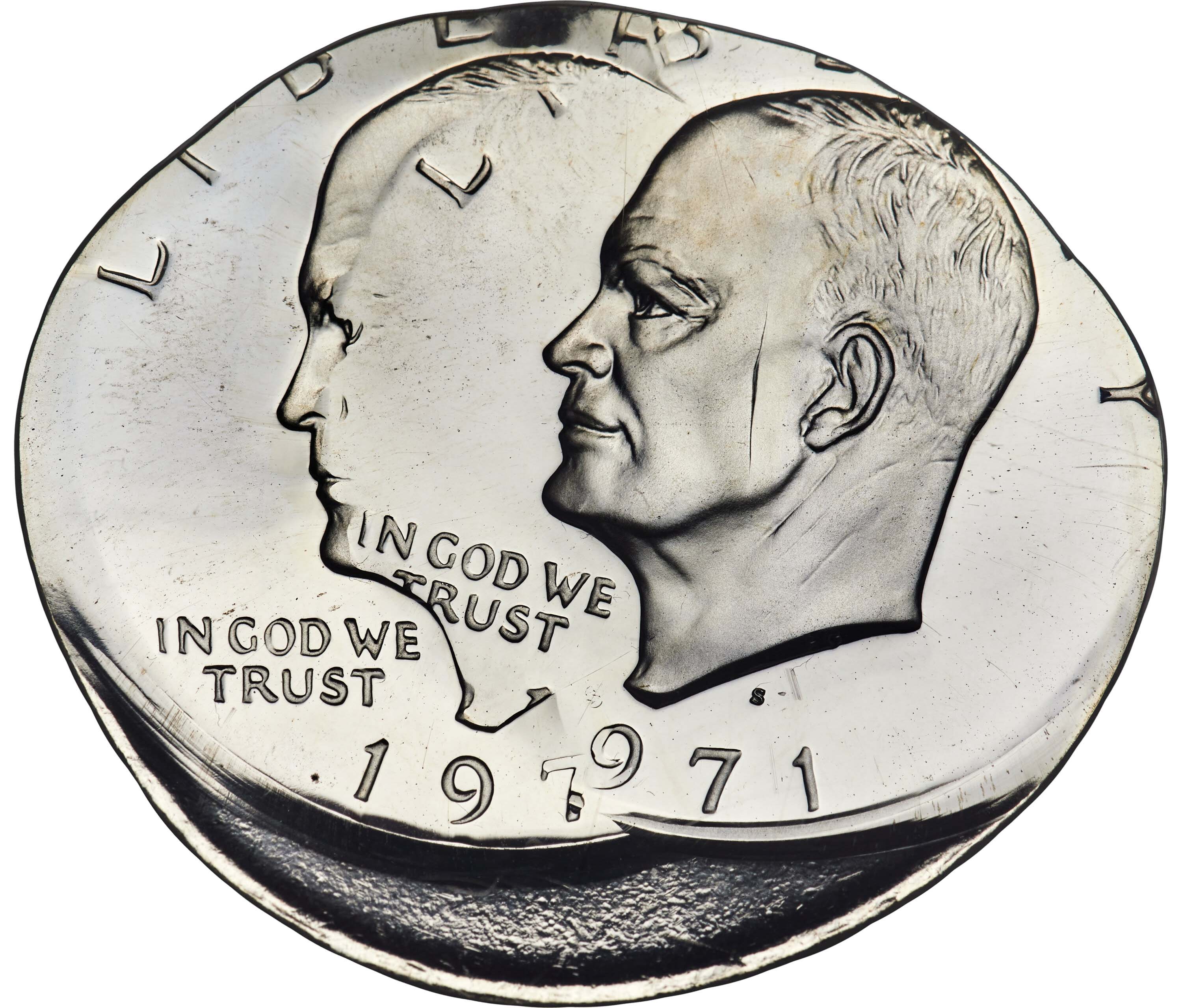

Undated Ike Dollar, PR66 Cameo
Double Struck, Both Strikes Off Center
Undated Eisenhower Dollar -- Double Struck, Both Strikes Off Center -- PR66 Cameo NGC. Type Three Reverse, with Cuba partly left of Florida on the planet Earth. The first strike was approximately 50% off center toward 7 o'clock. The second strike was approximately 40% off center toward 7 o'clock, at 2 o'clock relative to the first strike. No date or mintmark is present, but Type Three proofs were struck at San Francisco dated 1973, 1974, 1977, and 1978. Most of the Ike portrait from the second strike is bold. Ike's face is clear from the first strike. The second strike shows Earth and most of the eagle, while the eagle's left (facing) wing remains from the first strike.
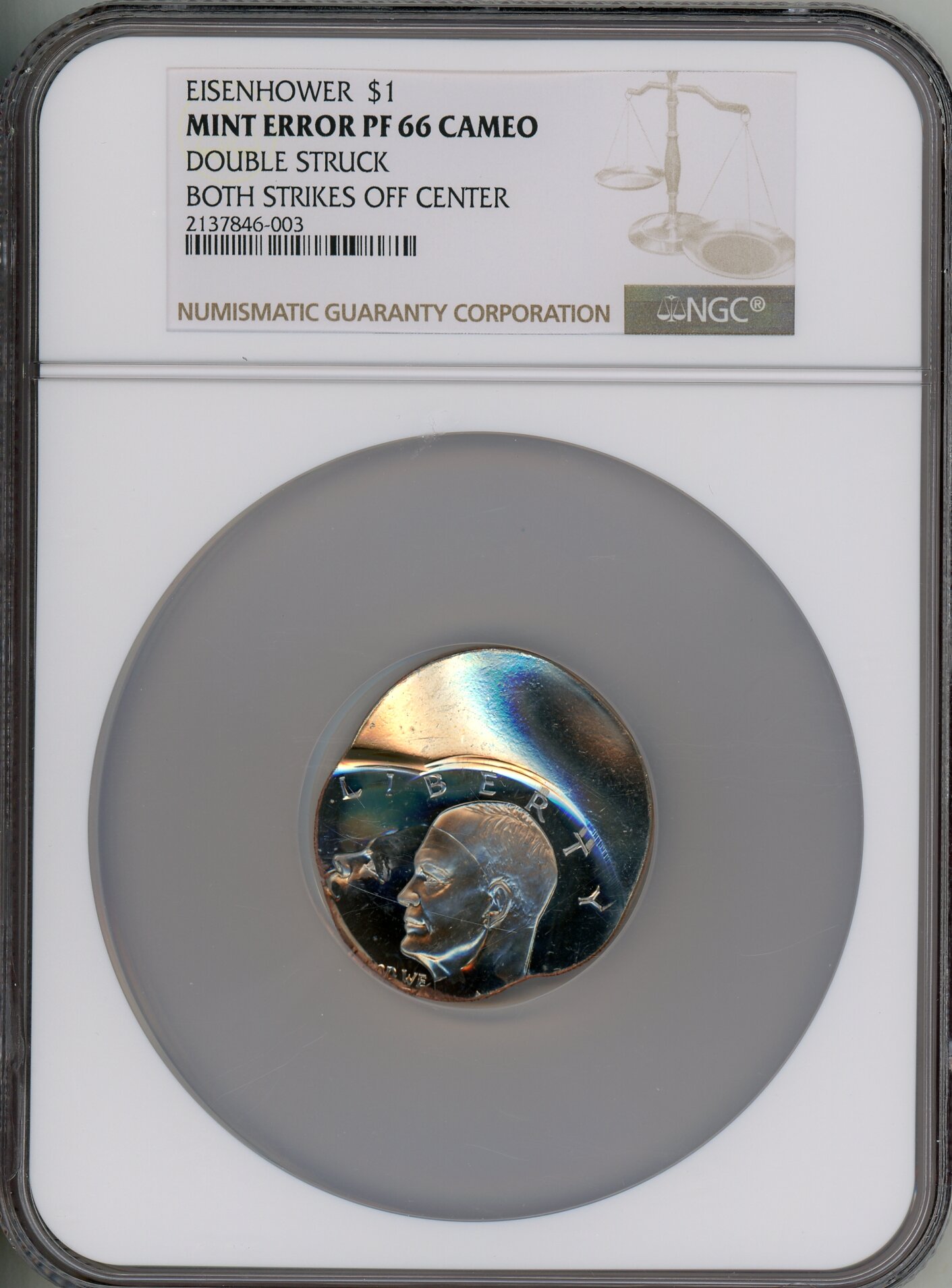

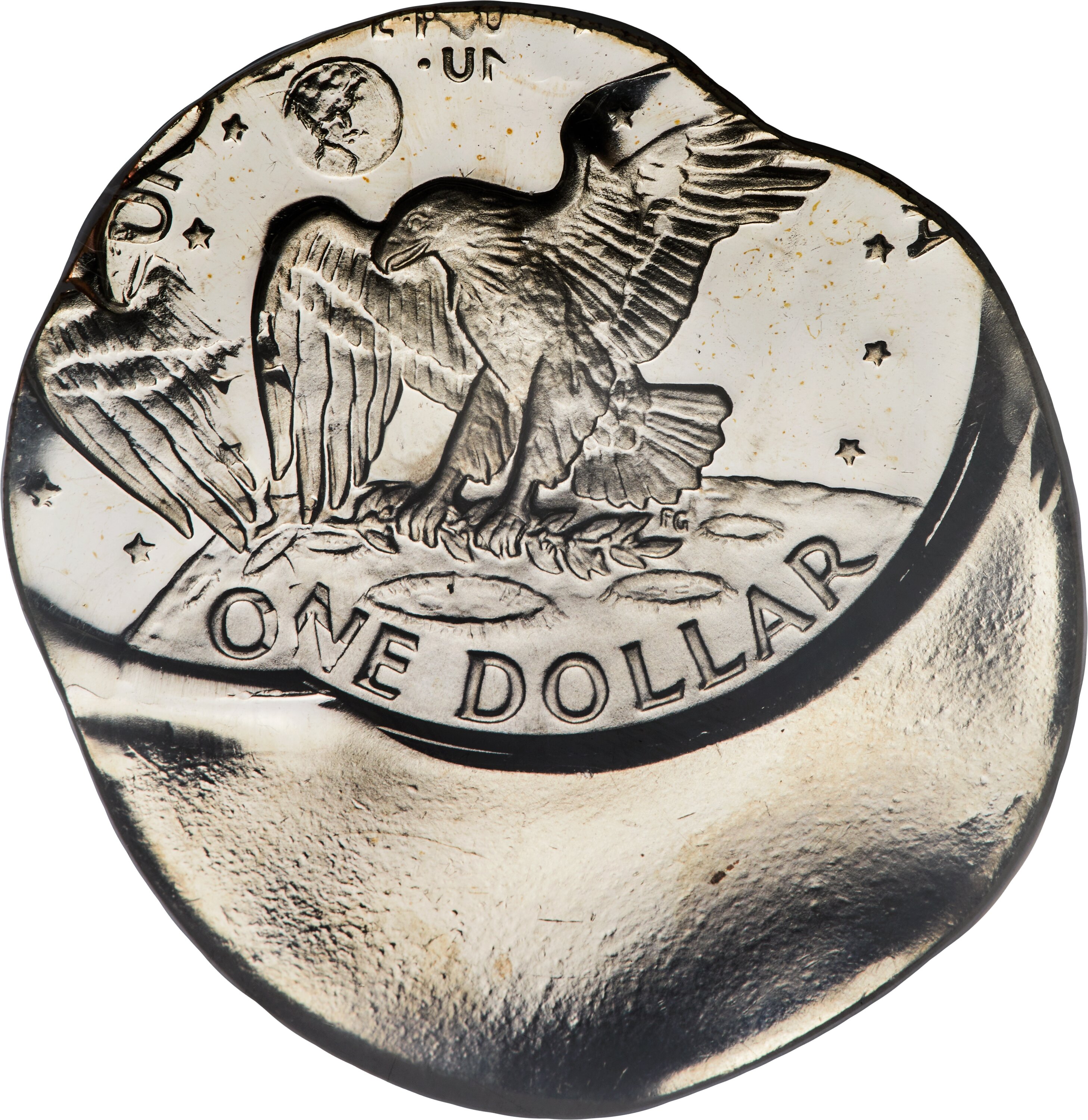
1907 Double Eagle, MS62
Double Struck
Second Strike Partial Collar
1907 $20 Liberty Double Eagle -- Double Struck, Second Strike Partial Collar -- MS62 NGC. The two strikes are mostly aligned, although some doubling appears on the reverse border legends. The initial strike was normal and fully in collar, resulting in a normal coin. However, the coin did not fully eject from the press and the second strike occurred with the coin still partially inside the collar. The result is a "shelf" on the edge of the coin from the collar that was partially seated on the second strike. Overall luster is warm with wheat-gold hues and minor abrasions consistent with the grade.
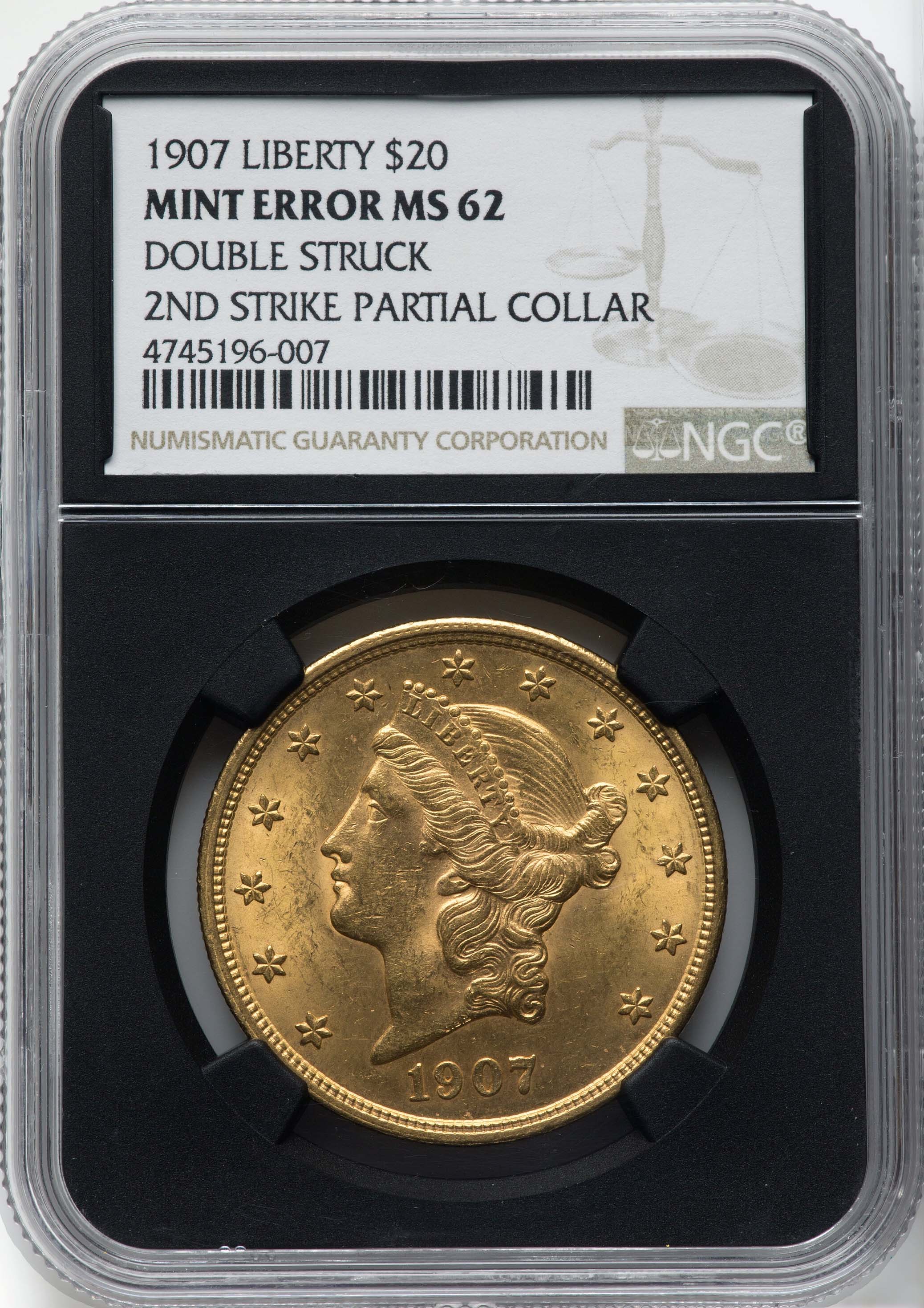
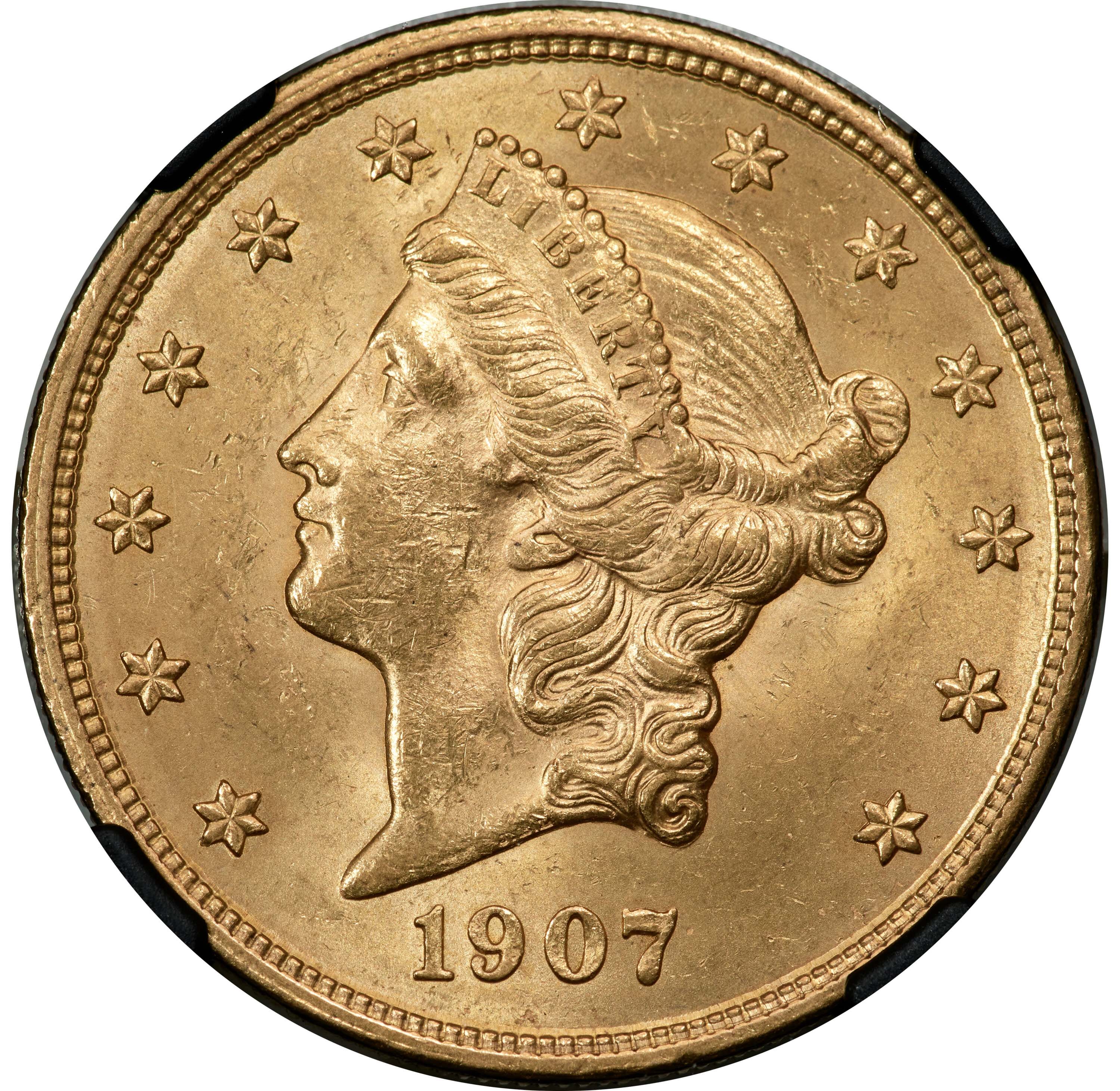
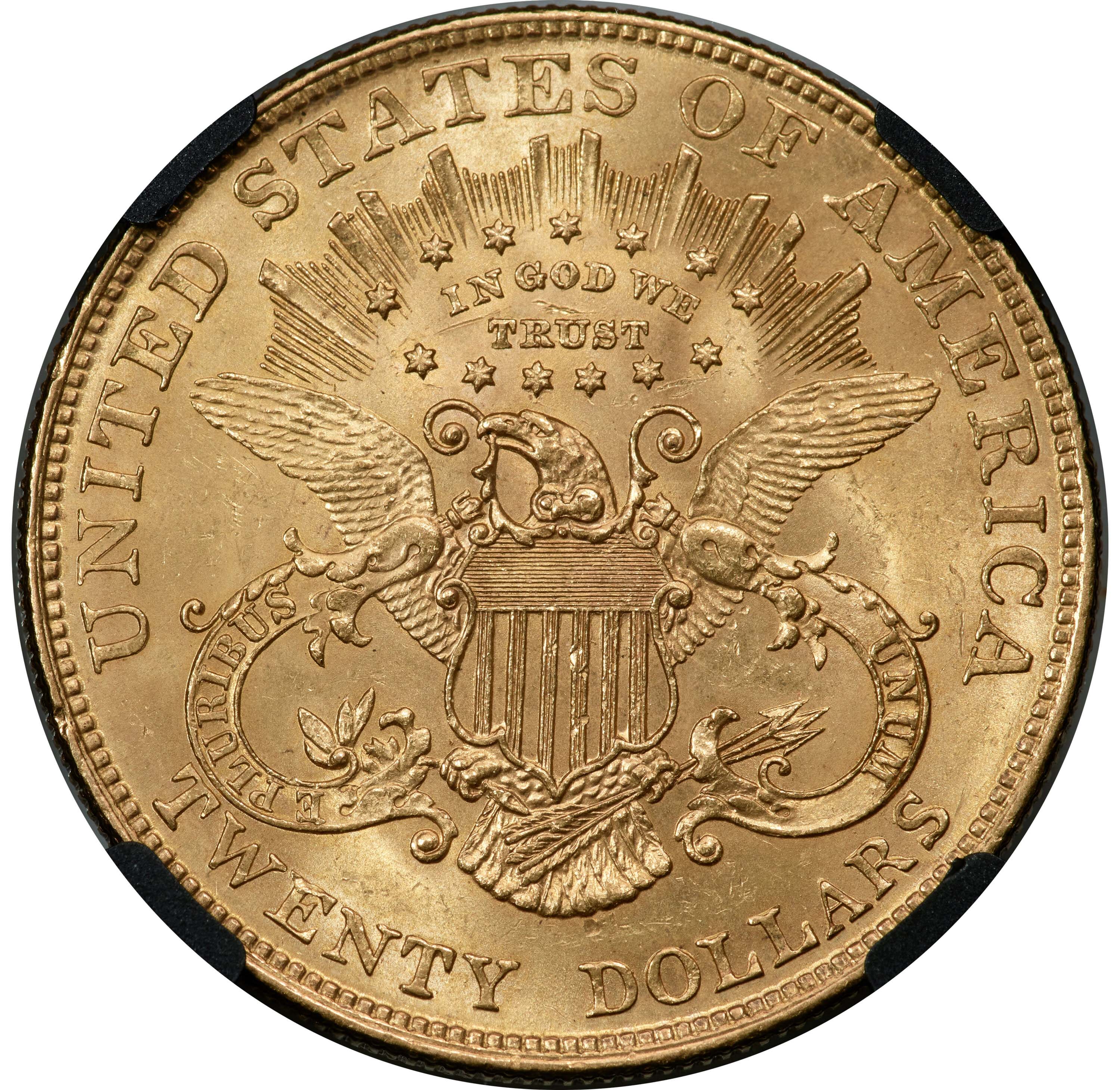
1944 'Steel' Lincoln Cent, MS64
Rare Transitional Alloy Error
Tied for Finest Certified
1944 1C Struck on a Zinc-Coated Steel Planchet MS64 PCGS. In an effort to preserve copper for the war effort, the United States Mint struck Lincoln cents on zinc-coated steel planchets in 1943, creating the famous "steel" cents that all collectors of the series are familiar with. Some extremely rare cents were accidentally struck on leftover bronze planchets at all three U.S. Mints in 1943, creating the legendary 1943 "copper" cents, perhaps the most famous and sought-after mint errors in U.S. numismatic history.
The phenomenon repeated itself in reverse the following year, when the Mint switched back to the familiar bronze planchets that were made from recycled shell casings. Again, a few specimens were accidentally struck on leftover "steel" planchets from the previous year, which are believed to have been stuck in the lids of the tote bins used to feed blank planchets into the coin presses during the striking process. These leftover zinc-coated steel planchets apparently were dislodged when the bins were refilled with bronze planchets in 1944 and struck as part of the regular production run.
Alternatively, it is possible some 1944 "steel" cents were struck on planchets intended for the production of Belgian two-franc pieces, which were struck on contract by the U.S. Mint in 1944. This foreign coinage was deliberately designed to use up the remaining 25 million zinc-coated steel planchets leftover from the Lincoln cent production of the previous year.
Though not as well known as the 1943 "copper" cents, the 1944 transitional alloy error "steel" cents are sought-after rarities today. NGC has certified only four 1944 "steel" cents, all in AU grades, while PCGS has graded 11 examples, three in AU and eight in Mint State, but none finer than MS64 (3/24). PCGS CoinFacts estimates 25-30 examples are extant, but many are not graded because of corrosion, to which this alloy was especially vulnerable. The record price realized for the issue belongs to the MS64 PCGS example in lot 3043 of the U.S. Coins Signature Auction (Heritage, 6/2021), which realized $180,000.
The present coin is a spectacular Choice example that exhibits a better than average strike for the issue, which is always seen with some softness on the high points of the devices. The coin presses' pressure settings were high enough to strike the softer bronze planchets intended for regular production, but they were inadequate to fully bring up the details on the harder "steel" planchets. The well-preserved brilliant surfaces are free of mentionable contact marks, but some scattered alloy spots are evident on both sides. This coin is tied with three other specimens at PCGS for finest-certified honors. We expect intense competition from series specialists, error collectors, and Registry Set enthusiasts when this lot is called. Population: 4 in 64, 0 finer (3/24).
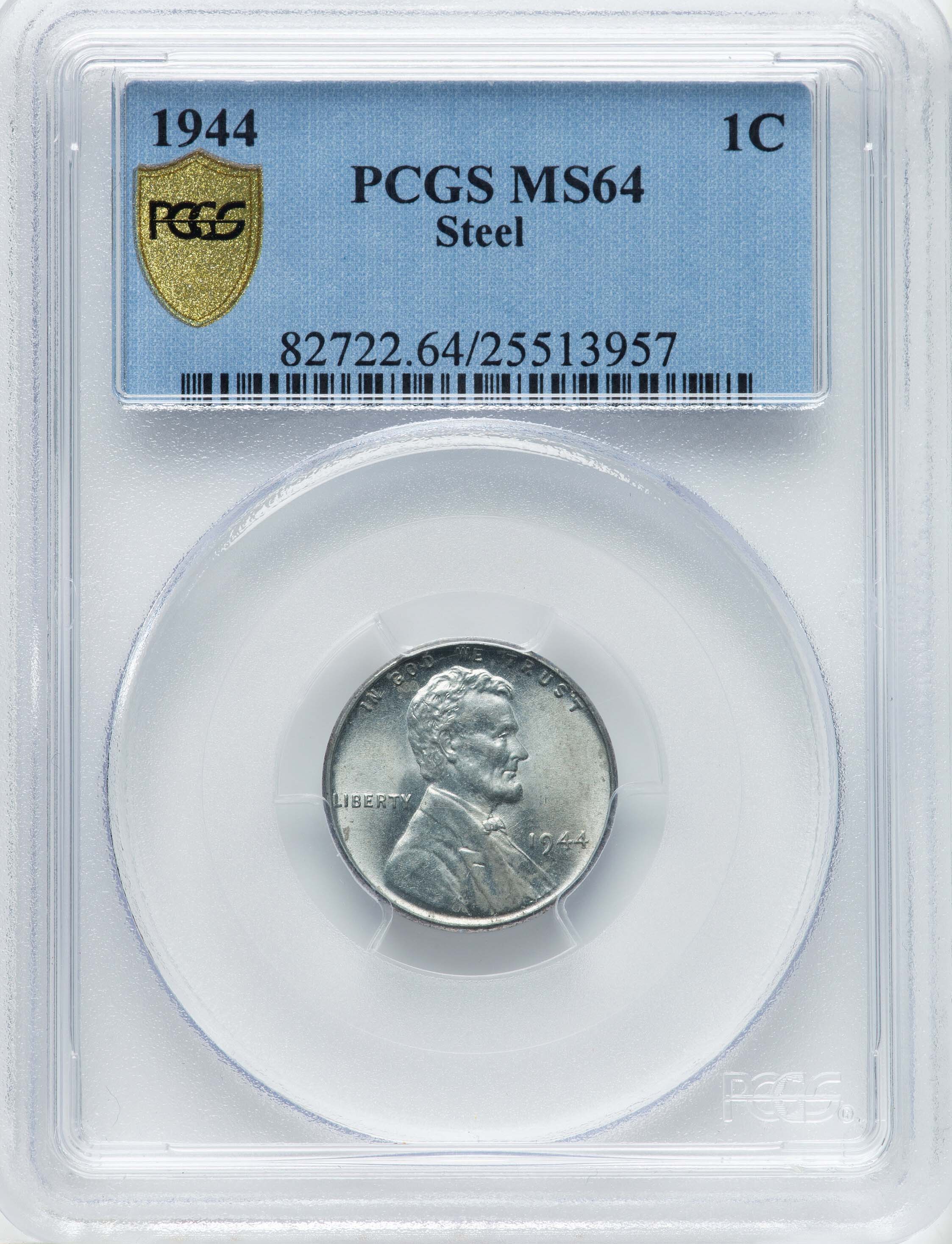
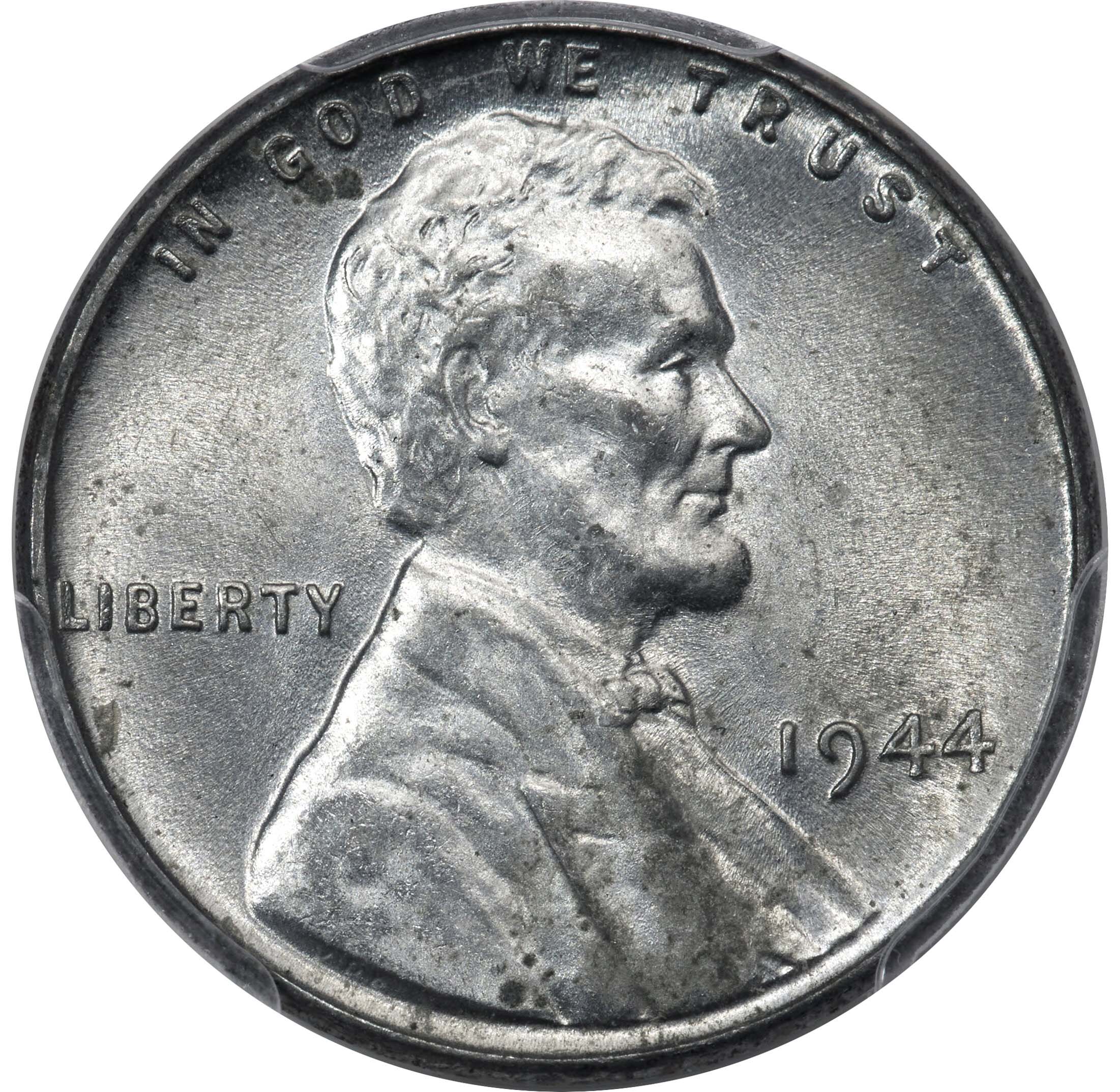
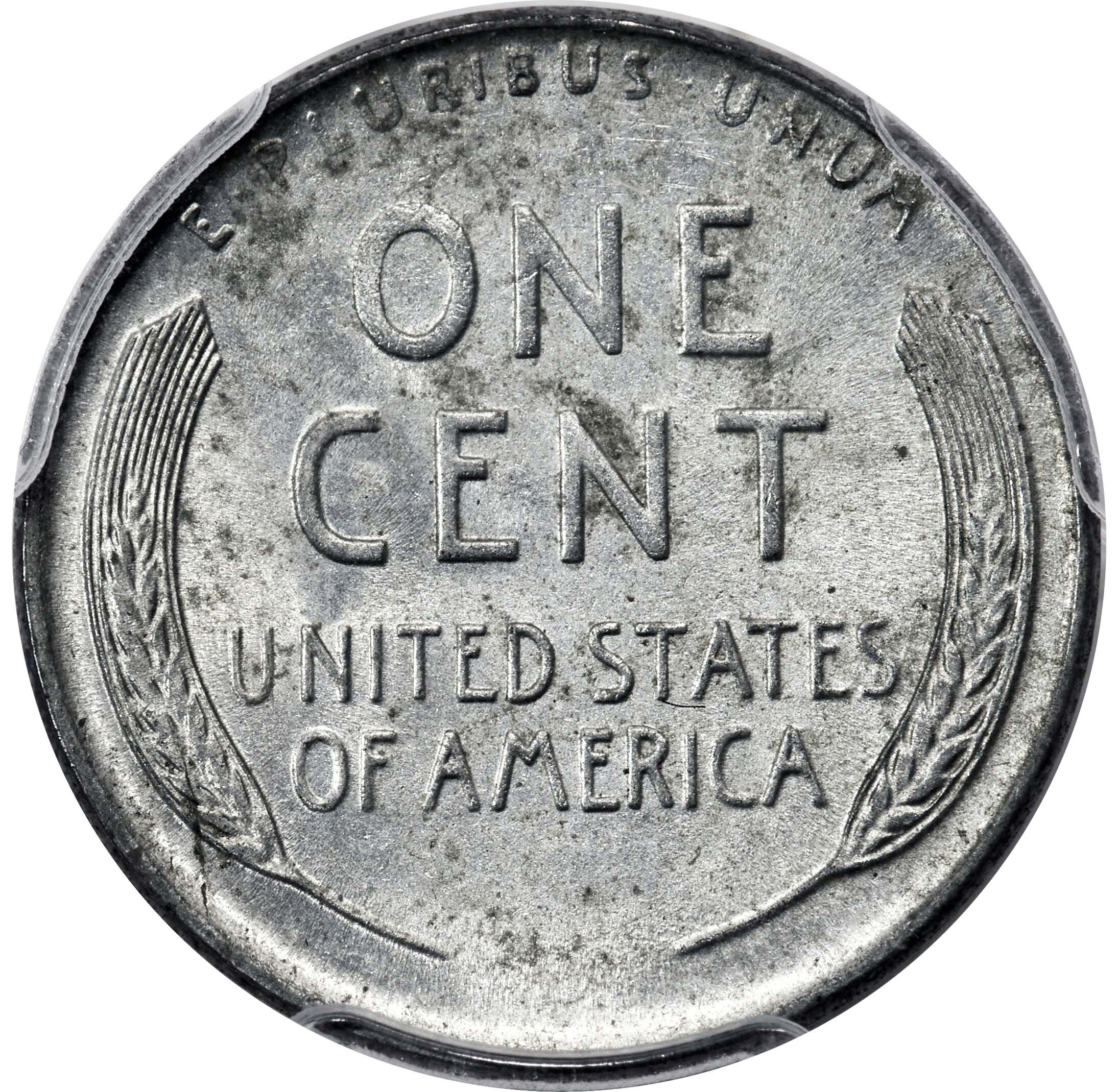
1974-D Eisenhower Dollar, MS63
Struck on a 40% Silver Planchet
Important Wrong-Planchet Error
1974-D $1 -- Struck on 40% Silver Planchet -- MS63 PCGS. The small number of 1974-D and 1977-D Eisenhower dollars struck on 40% silver planchets have long fascinated collectors, not only for the general popularity of wrong-planchet errors but also for the fact that the Denver Mint should not have had any silver-clad planchets to inadvertently use for coinage. Silver-clad Ike dollars were only produced at the San Francisco Mint, in proof and business strike format, from 1971 to 1974, and then again in 1975 (for the Bicentennial coins dated 1976). According to San Francisco Mint practice during that period, silver-clad planchets slated for proof coinage that did not meet the quality standards of the proof coinage process, were instead used for business strike silver-clad coinage at the same branch mint; contrastingly, copper-nickel planchets slated for proof coinage that did not meet the quality standards of the proof coinage process, were shipped to the Denver branch mint to be used for circulation production, since San Francisco did not strike non-proof copper-nickel dollars.
In his Encyclopedia, Walter Breen noted: "The Mint Bureau confirmed that an unknown number of silver clad blanks were accidentally included among nickel clad blanks unfit for proof coinage and shipped from the San Francisco to the Denver Mint". It is believed that this shipping error produced the small stock of silver-clad planchets at the Denver Mint, which ultimately yielded Denver-minted wrong-planchet errors in 1974, 1975 (Bicentennial coins), and 1977 (from leftover planchet stock).
Most researchers estimate that 10 to 30 silver-clad errors were struck at Denver for each of the three dates referenced above, or at least for the 1974-D and 1977-D occurrences. The 1974-D silver-clad dollar was first reported on October 10, 1974 by a Las Vegas blackjack dealer. Most examples found were in the Nevada area, in the Fall of 1974, and number about 25 pieces today. Seven examples have been certified by ANACS as Mint State, including there in MS63, three in MS62, and one in MS61, with unknown duplication possibilities. Regarding the 1976-D Type II silver-clad coin, Q. David Bowers reported in A Guide Book of Modern United States Dollar Coins (2016) that the error is "exceedingly rare, possibly unique," with a single piece owned by James Sego. The 1977-D silver-clad coin was first reported in the February 22, 1978 issue of Coin World, and about 20 pieces are known.
This 1974-D piece displays satiny, brilliant-white luster with the distinctive silver dollar appearance. The coin is well struck, and abrasions are minimal for the grade, giving the coin eye appeal superior to norms for its grade. For collectors seeking an example of this rare wrong-planchet error, the current coin represents an ideal acquisition not easily surpassed.

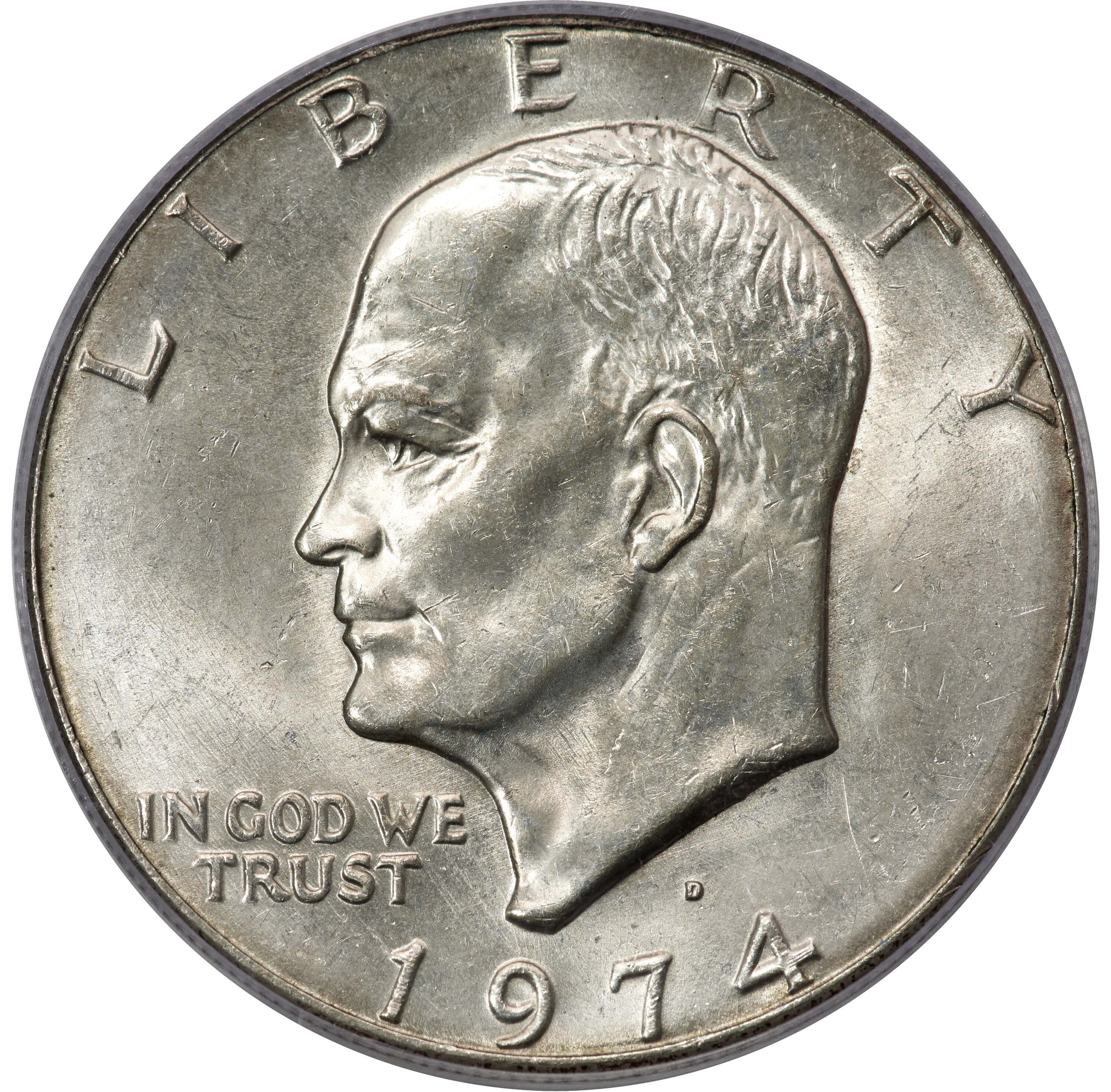
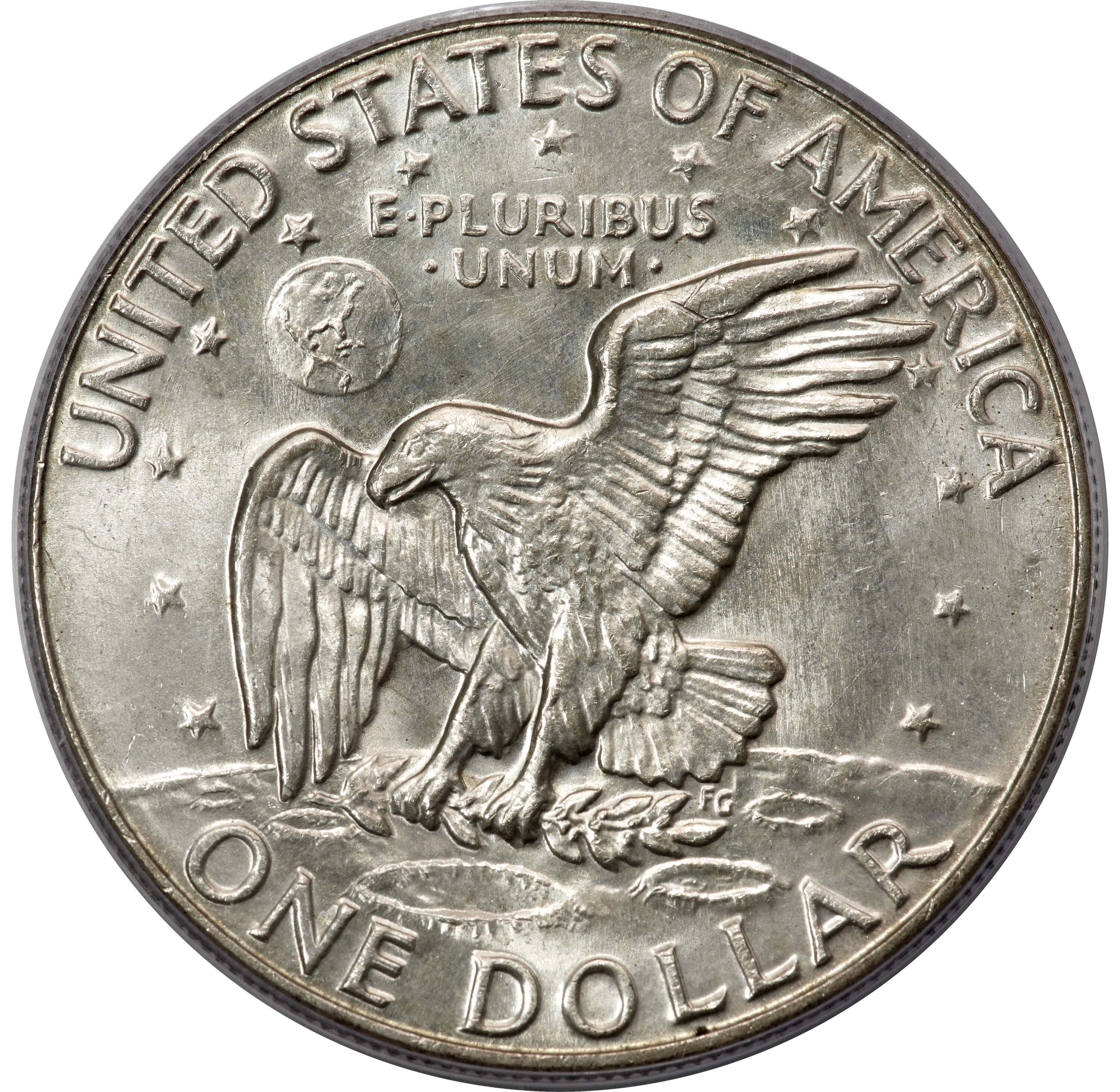
Undated Double Eagle Uniface Die Trial, MS62
Judd-A1857-7, Paquet's Reverse Design
Undated (1857) DT$20 Reverse Double Eagle Die Trial, Judd-A1857-7, Pollock-3149, R.7, MS62 PCGS. A small Heraldic eagle, its wings outstretched, clutches three arrows and an olive branch, holding a ribbon inscribed E PLURIBUS UNUM in its beak. The statutory legend begins and ends above the wing tips, and the denomination is below. Struck in white metal. These trials are typically dated to 1857 although may have been produced as late as 1860. This example, one of just five known, has light gray surfaces with subtle blue overtones and scattered spots, including a concentration above DO of DOLLARS.
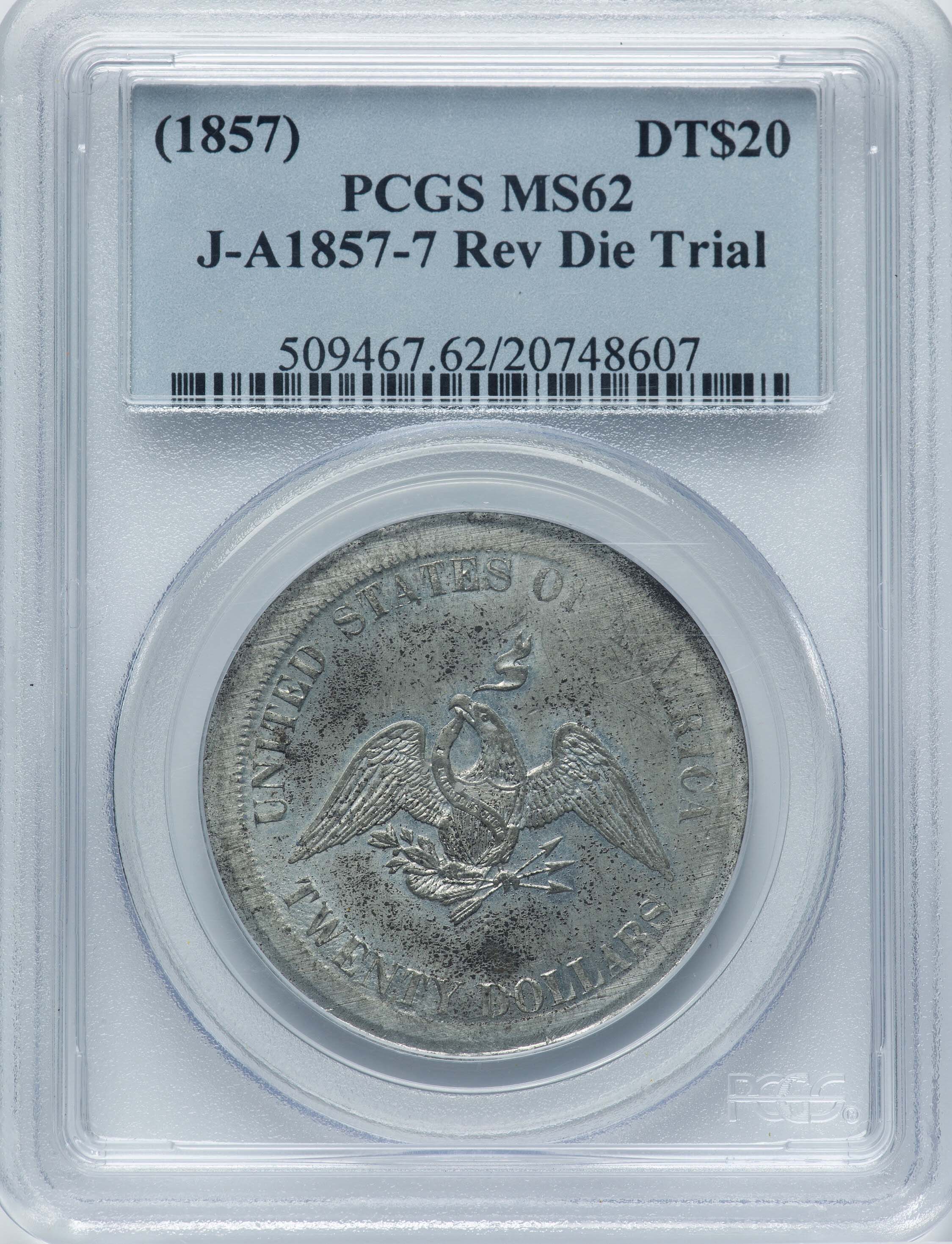
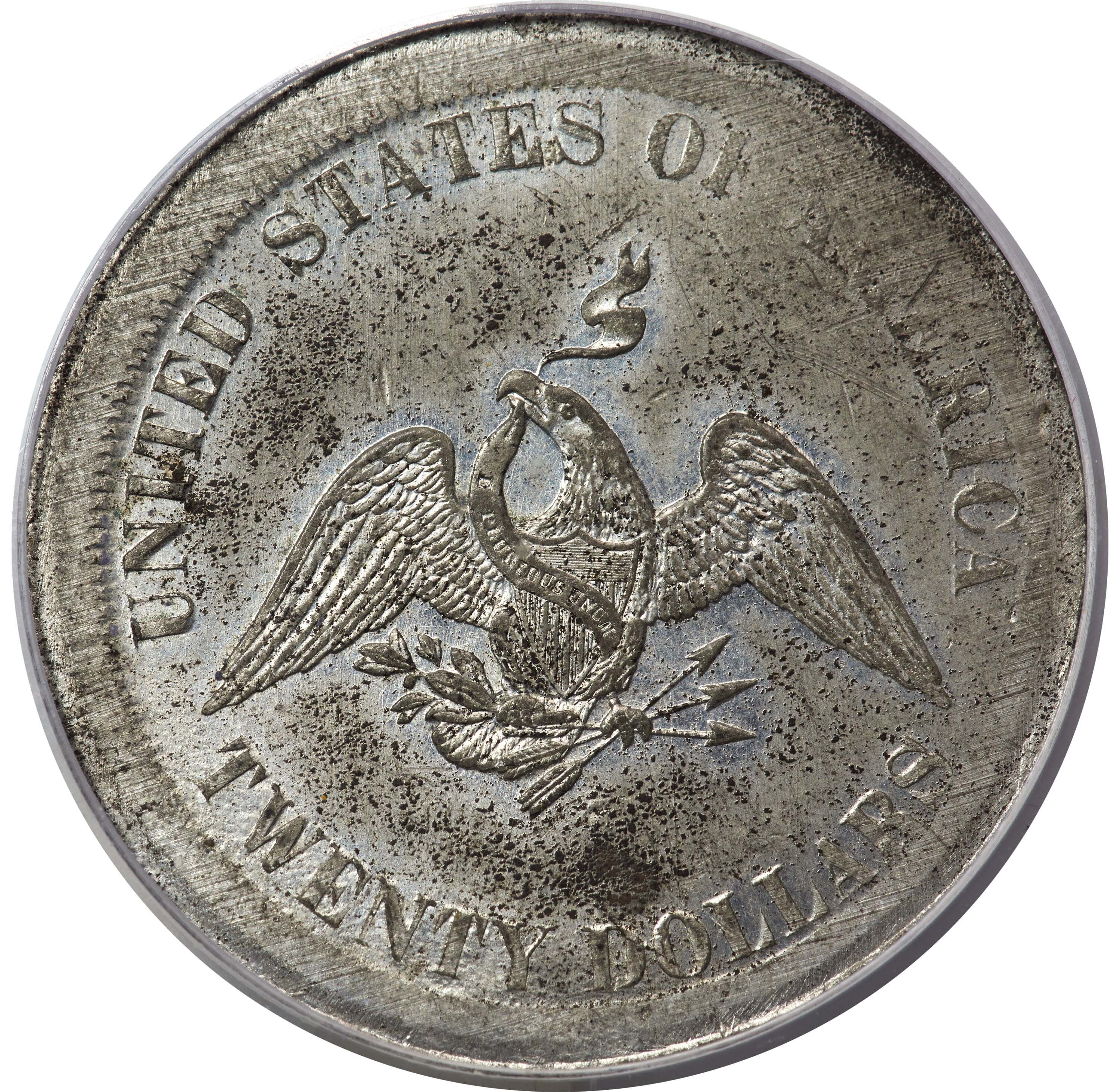
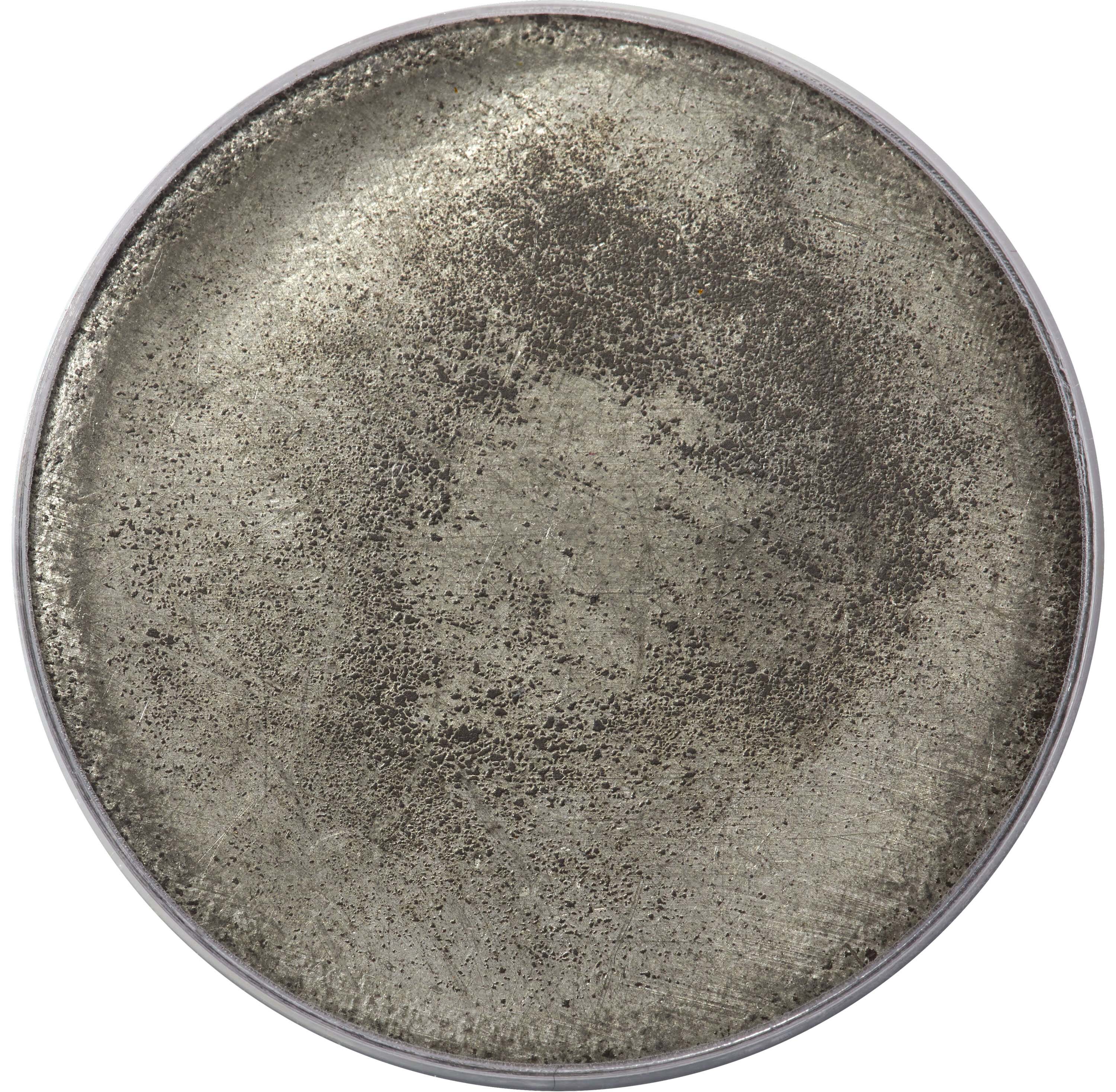
(1986-S) $1 Silver Eagle -- Die Setup Piece,
Obverse Image on Sandpaper Disc -- NGC
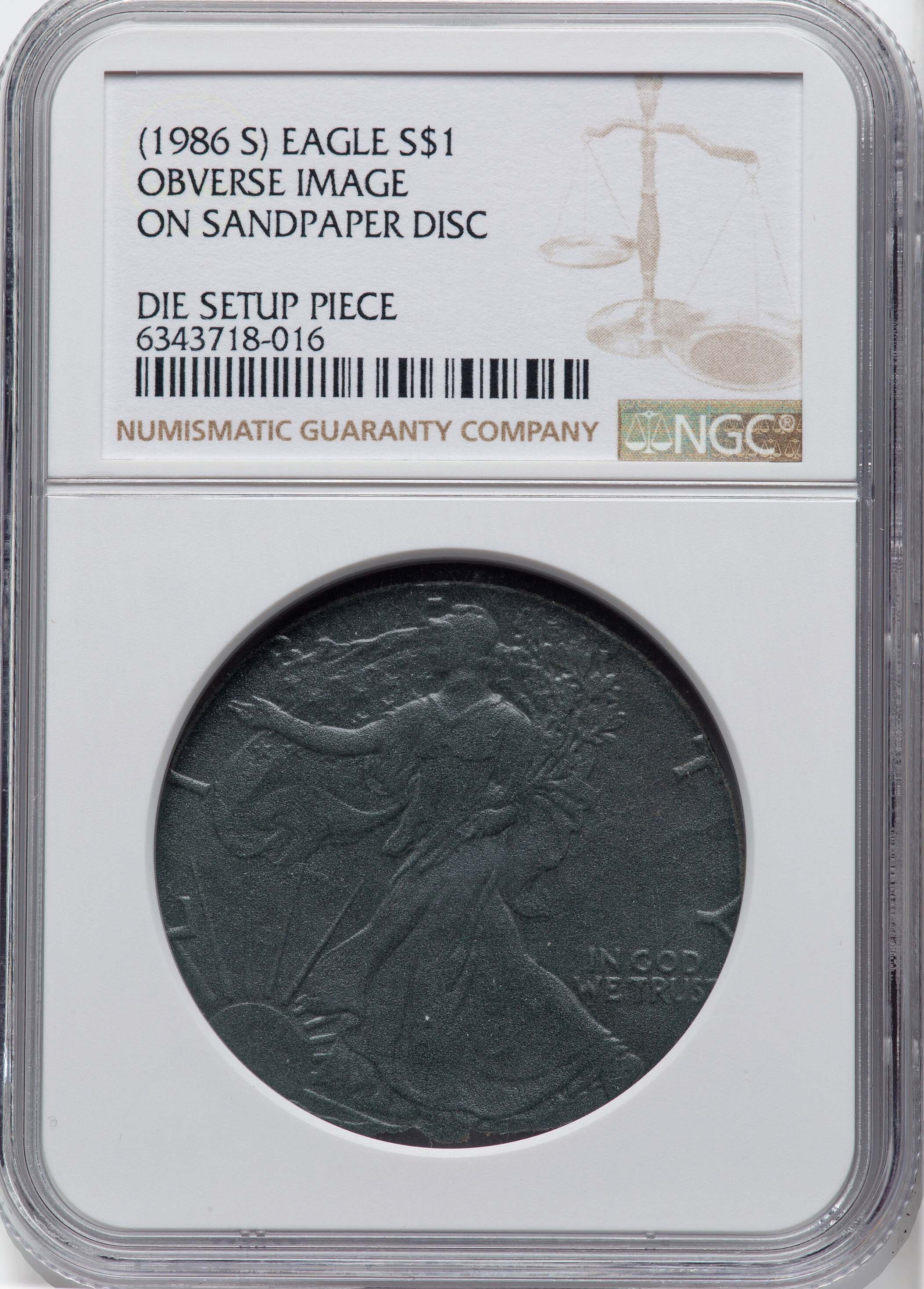
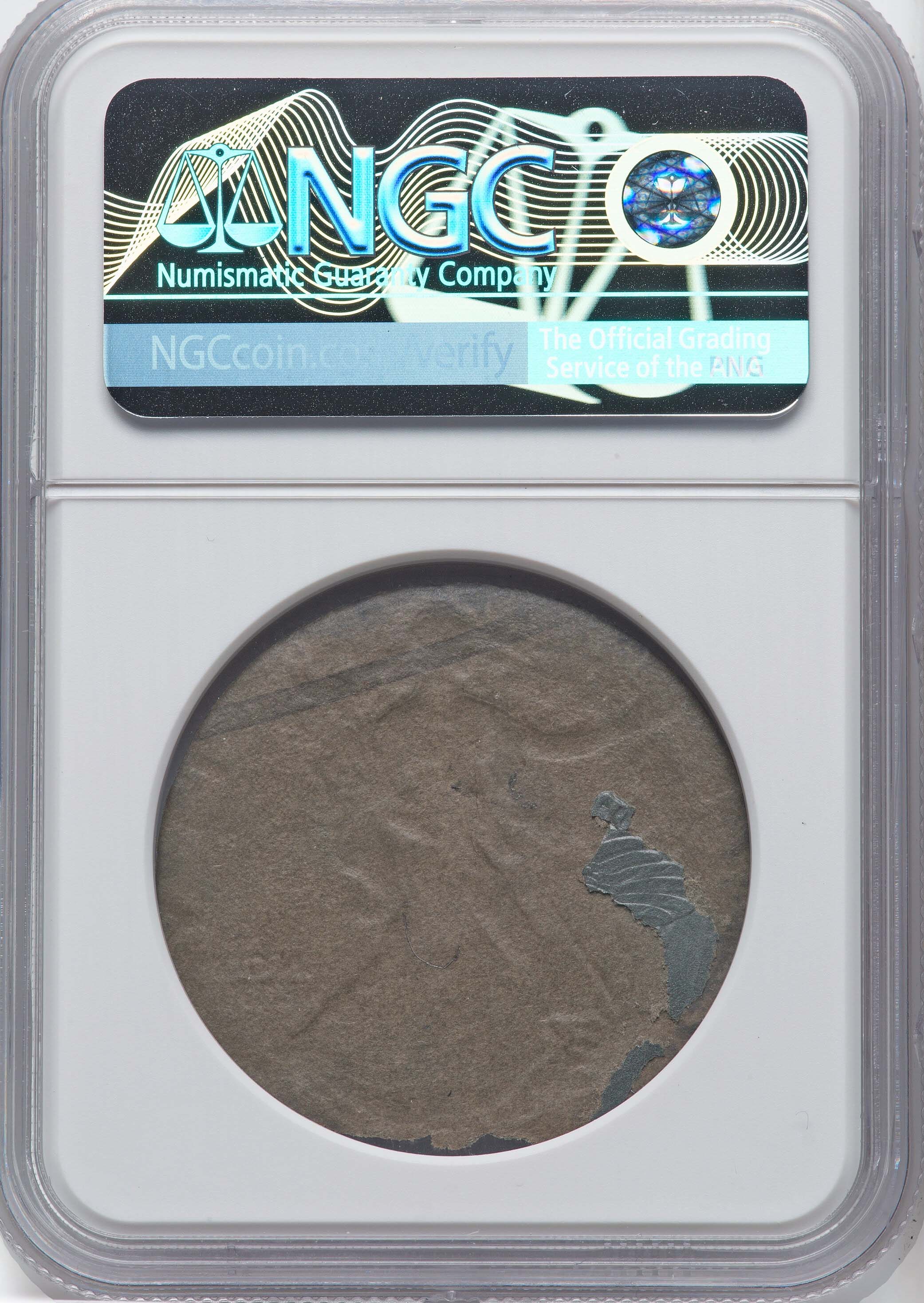
(1986-S) $1 Silver Eagle -- Die Setup Piece,
Reverse Image on Sandpaper Disc -- NGC
